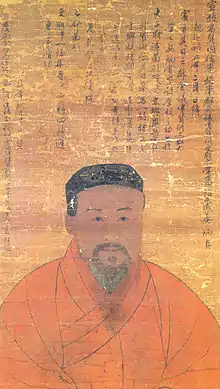| Ahn Hyang | |
 Portrait of Ahn Hyang, held by Sosu Seowon, Yeongju, North Gyeongsang | |
| Korean name | |
|---|---|
| Hangul | 안향 |
| Hanja | |
| Revised Romanization | An Hyang |
| McCune–Reischauer | An Hyang |
| Art name | |
| Hangul | 회헌 |
| Hanja | |
| Revised Romanization | Hoeheon |
| McCune–Reischauer | Hoehŏn |
| Courtesy name | |
| Hangul | 사온 |
| Hanja | |
| Revised Romanization | Saon |
| McCune–Reischauer | Saon |
| Posthumous name | |
| Hangul | 문성 |
| Hanja | |
| Revised Romanization | Munseong |
| McCune–Reischauer | Munsŏng |
| Clan Origin | |
| Hangul | 순흥 |
| Hanja | |
| Revised Romanization | Sunheung |
| McCune–Reischauer | Sunhŭng |
Ahn Hyang (안향, 安珦; 1243 – 12 September 1306), also known as Ahn Yu (안유, 安裕), was a leading Confucian scholar born in Yeongju in present-day South Korea, and was from the Sunheung Ahn clan. He is considered the founder of Neo-Confucianism in Korea, introducing Song Confucianism to the Goryeo kingdom. Ahn Hyang visited China, transcribing the works of Zhu Xi and bringing his copy and portraits of Confucius and Zhu Xi to Korea to use in his revitalization of Confucianism. He strove to replace Buddhism with Confucianism.
There is a portrait of him at the Sosu Seowon, which was built as a memorial to the scholar. There is also a statue of him on Banya-san in Nonsan.
Family
- Grandfather
- Ahn Yeong-yu (안영유, 安永儒/安永濡) (1201 - ?)
- Grandmother
- Lady Park of the Gyeongju Park clan (경주 박씨); daughter of Park Hwang (박황, 朴璜)
- Father
- Ahn Bu (안부, 安孚) (1220 - ?)
- Mother
- Princess Consort Sunjeong of the Gangju Woo clan (순정군부인 강주우씨, 順政郡夫人 剛州禹氏)
- Grandfather - Woo Seong-yun (우성윤, 禹成允)
- Princess Consort Sunjeong of the Gangju Woo clan (순정군부인 강주우씨, 順政郡夫人 剛州禹氏)
- Wives and their children
- Princess Consort Hannam of the Kim clan (한남군부인 김씨, 漢南郡夫人 金氏); Kim Rok-yeon's third daughter (김록연,金祿延)
- Son - Ahn Woo-gi (안우기, 安于器) (1265 - 1329)[1]
- Daughter-in-law - Princess Consort Cheorwon of the Choi clan (철원군부인 최씨)
- Grandson - Ahn Mok (안목, 安牧)
- Daughter-in-law - Princess Consort Yi (군부인 이씨)
- Grandson - Ahn Shin (안신, 安愼)
- Daughter-in-law - Princess Consort Cheorwon of the Choi clan (철원군부인 최씨)
- Daughter - Lady Ahn of the Sunheung Ahn clan (순흥 안씨, 順興 安氏)
- Son-in-law - Moon Ok (문욱, 文頊)
- Daughter - Lady Ahn of the Sunheung Ahn clan (순흥 안씨, 順興 安氏)
- Son-in-law - Heo Su (허수, 許綏)
- Daughter - Lady Ahn of the Sunheung Ahn clan (순흥 안씨, 順興 安氏)
- Son-in-law - Park Je (박제)
- Daughter - Lady Ahn of the Sunheung Ahn clan (순흥 안씨, 順興 安氏)
- Son-in-law - Han Su-yeon (한수연, 韓守延)
- Daughter - Lady Ahn of the Sunheung Ahn clan (순흥 안씨, 順興 安氏)
- Son-in-law - Kim Sa-won (김사원, 金士元)
- Son - Ahn Woo-gi (안우기, 安于器) (1265 - 1329)[1]
- Princess Consort Seowon of the Yeom clan (서원군부인 염씨, 瑞原郡夫人 廉氏); daughter of Yeom Su-jang (염수장, 廉守藏) — No issue.
- Princess Consort Hannam of the Kim clan (한남군부인 김씨, 漢南郡夫人 金氏); Kim Rok-yeon's third daughter (김록연,金祿延)
References
- ↑ Through his son, Ahn Hyang became the 26th great-grandson of Ahn Jung-geun
- tourinfo.khu.ac.kr/iboard/bbsUpFiles/제%205호.hwp
- Grayson, James H. 2002 Korea - A Religious History. RoutledgeCurzon. ISBN 978-0-7007-1605-0.
This article is issued from Wikipedia. The text is licensed under Creative Commons - Attribution - Sharealike. Additional terms may apply for the media files.